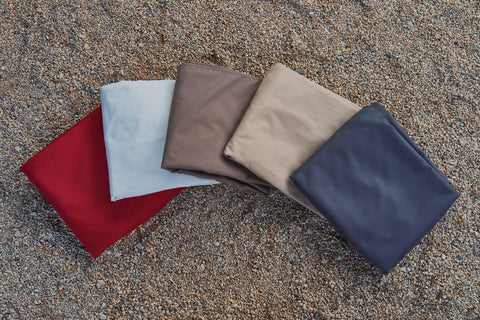Which parasol colour best protects from the sun?
As summer swiftly approaches, investing in a parasol becomes essential for enjoying sunny days in your outdoor space while staying protected from the sun. The market offers a plethora of parasol models, whether cantilever or straight, with round, rectangular, or square canopies. So, how do you make the right choice amidst these options?
Dark vs. light colours: What's the difference?
To shield effectively against UV radiation, employing parasols, wearing UV protection clothing, applying sunscreen, and avoiding sun exposure during peak hours are crucial. Generally, dark colours absorb more UV light than light colours. Dark tones such as black, charcoal grey, red, blue, and green have a higher UV light absorption rate than light tones like white, yellow, and beige. Consequently, a dark-coloured canopy, like a black parasol, is more effective and typically offers a higher UPF rating. In contrast, a light-coloured parasol canopy provides lesser UV protection.
This is because dark pigments absorb a significant amount of light across all wavelengths, whereas pigments in lighter colors absorb only a limited amount.
When choosing your parasol, it's crucial to ensure that it effectively protects you from the sun. To do this, it's essential to check that the parasol provides effective protection against high UV indices.

Ultraviolet light (UV)
Ultraviolet light is a form of energy emitted by the sun. Invisible to the human eye, it can be measured using specific instruments, referred to as the UV index. There are three types of UV radiation: UVA, UVB, and UVC.
UVA rays constitute the majority of UV light that reaches the Earth's surface, penetrating deep into your skin, causing wrinkles, skin discoloration, and associated with certain types of cancer.
UVB rays are less intense but cause sunburn and an increased skin cancer risk. They're more effectively blocked by the ozone layer, which, regrettably, is diminishing.
UVC rays are the most dangerous but are fortunately blocked by the ozone layer and do not reach the Earth's surface.
Excessive sun exposure without protection can damage skin cells, leading to long-term harm and increased cancer risk. For superior UV protection, dark shades are more effective than light ones, offering excellent SPF protection. It's advisable to choose dark colours for your parasol canopy, such as black, charcoal grey, blue, or taupe.
Regarding the sensation of heat beneath a parasol's canopy, light colours tend to provide a cooler feeling compared to dark colours. This difference is because light colours reflect more solar radiation, while dark colours absorb more heat. Thus, being under a light-coloured canopy may offer a more refreshing shaded area, an important consideration when selecting a parasol for sun protection.
The canopy's mesh can also affect the sensation of coolness. Indeed, a more open weave allows for better heat dissipation but may be more susceptible to rain.
Canopy materials and their characteristics
Ensuring that the umbrella is made with quality, weather-resistant, and fade-resistant fabric is crucial for optimal protection from the sun's harmful rays. Various materials, such as fabric, are used in umbrella canopies to provide the best possible UV protection. From black to vibrant colours, garden parasols come in a range of shades to complement any outdoor space. Whether for a patio or a garden, choosing the right umbrella for your needs is essential. So remember to consider factors like size, price, and compactness when selecting the best umbrella for protection from the sun.
Polyester is commonly used for parasol and outdoor awning fabrics. Polyester canopies are water-repellent and easy to clean but not fade-resistant unless solution-dyed. Their fade resistance is lower than olefin and acrylic but remains satisfactory for occasional use.
Olefin fabric is noted for its remarkable weather and UV resistance, in addition to being easy to maintain. This synthetic fiber offers exceptional sun protection, ensuring optimal durability for outdoor enjoyment without concern. All our olefin canopies are fade-resistant.
Acrylic, a high-quality synthetic material, is distinguished by its excellent weather and UV resistance, making it ideal for outdoor use. Its lightness and ease of maintenance make it a perfect choice for enhancing your outdoor space while ensuring exceptional durability. All our acrylic canopies are fade-resistant.
Cotton is highly valued for parasols, offering breathability and comfort. It has a positive environmental impact and good water resistance. However, it fares poorly against UV rays, which discolor and damage its fibers, leading to tearing after one or two seasons. Cotton is not as water-resistant as olefin and acrylic.

Conclusion
A parasol is the best equipment for protecting yourself from harmful UV rays and enjoying the sun in your garden. Sun umbrellas come in a variety of colors and designs, ensuring that you find the perfect one to match your outdoor space.
When choosing a parasol, it is important to prioritize UV protection. Look for a canopy that offers optimal shielding from the sun's harmful rays. Dark-colored canopies, such as black, charcoal grey, blue, or taupe, are recommended for their higher UPF rating. Not only do these darker colors provide better UV protection, but they also add a touch of elegance to your patio.
In addition to UV protection, make sure to consider the quality of the fabric used for the canopy. A durable and weather-resistant fabric will ensure that your parasol withstands both rain and heat, providing you with long-lasting shade.
Whether you're looking for a regular patio umbrella or a cantilever parasol, it is essential to choose one that offers the best protection from the sun. Don't compromise on your safety and comfort when enjoying outdoor activities.
So, whenever you're spending time outdoors, make sure to have a parasol with you. It will shield you from the harmful rays of the sun and provide a cool and comfortable space to relax in.
















